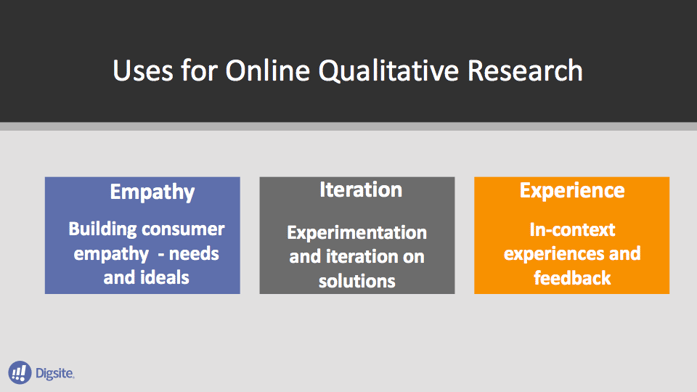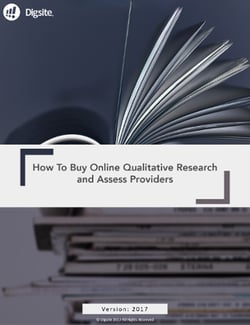Many of us spent the better part of our careers using in-person research to drive deeper consumer insights and empathy. Whether sitting in the back room at a focus group facility or watching people in-market, there was power in observing facial expressions and body language.
But a lot has changed in the past few years. The use of social media and mobile devices has opened the door to rich consumer insights that don't involve travel. Now, your team wants to tap the power of online qualitative to capture in-context experiences and quickly understand problems and iterate on solutions.
In this blog, I discuss the recent advances in online qualitative and map out an approach to converting your research from in-person to online qualitative, so your team can unlock the true power newer agile qualitative approaches provide.
What can agile online qualitative accomplish?
Whether your focus is marketing, innovation or customer experience, many of the research objectives you traditionally looked to improve with in-person research can now be satisfied in an online environment—and with better results.
However, we’re not simply talking about “online focus groups” in the sense of getting these same groups of people into a single video chat. Newer approaches to online qualitative bring participants into social media-style spaces where they can have private or group conversations with moderators, share pictures and videos, and even have live video interviews with moderators. This approach offers much more flexibility and richer data quality than the online tools that existed even five years ago.
With that in mind, let’s take a look at three common objectives historically reserved for in-person research: building empathy, iterating on ideas and capturing customer experiences.

While not all online tools offer the same set of capabilities, this should give you a basic idea of what to expect from modern online qualitative research methods.
1. Building empathy
One of the biggest gaps left by big data and quantitative research is empathy. If we can’t relate to the emotional aspects of our target—their joys and frustrations—it's very hard to prioritize and communicate features, messages or innovations.
In-person and online qualitative provide different data on empathy. Think of it as the difference between how you relate to your family when you meet them in person versus what it’s like to send them an email or a note on social media. In all three cases, you can get rich emotional context. But the way you share and communicate is clearly different.
Let’s look at a specific example of how the process of building empathy differs in-person compared to online. Imagine we want to understand more about the home improvement market and bathroom remodeling. Below are three approaches that show how your questions might differ.

In the focus group example, you would ask the group a series of questions about their process, potentially drilling down further with two or three participants before moving on to the next question. To get the group to share feelings that might be hard to articulate directly, you may use a projective technique like the amusement park question to get the participants to relax and open up.
In an in-home interview, you might be focused a bit more on show-and-tell, drilling deeper with each person on the details of their specific process and looking for unarticulated problems or needs.
With online qualitative, you get a bit of both. You can ask a series of questions and probe with individual or group follow-ups and you can also get the show-and-tell type insights by having them share photos or videos.
2. Iteration
Today’s most successful teams are agile. They move quickly—always.
One of the true benefits of online qualitative is the ability to build, optimize and iterate on ideas. Let’s look at how this works in-person and online—both within a single group and across multiple groups.
Let’s say we had some early ideas for bathroom products that helped increase usable counter space and storage.

When building concepts, you are typically looking to prioritize needs or benefits, get detailed feedback on a series of concepts and either narrow down the list of concepts or create new or improved concepts based on your learning.
Online qualitative has some distinct benefits over in-person research in this type of research:
- Larger sample sizes. You gain some benefits typically associated with quantitative research such as larger sample sizes (n=50-100) and national samples.
- Less bias. Online qualitative enables you to minimize bias by randomizing concept orders and having participants give private feedback before group discussions.
- It’s easier to follow up. You also get the iterative ability to go back to the entire group to vote on a generated list of needs and benefits generated within the qualitative research.
- And follow up again. Once that’s done, you also have the iterative ability to show participants the new ideas and concepts that were generated from the group.
One of the challenges of online research can be the stimulus you show. You will need to be able to either represent your concept with a photo or video or mail participants a physical stimulus to evaluate. If your company deals in patented products, you will want to make sure you have participants sign non-disclosure agreements within the online platform. You may also want to take additional identify verification measures while recruiting research participants.
One of the benefits of online qualitative for concept iteration is the benefit of participants being able to make more direct comparisons to competitive concepts they are familiar with or currently using—instead of being limited to competitive stimuli you might share with them at a focus group facility. In other words, the participants might provide data that you otherwise wouldn’t have gotten during an in-person interview because they can draw on their own experiences instead of being prompted by a specific stimulus.
3. Customer experiences
Capturing and understanding experiences is a critical part of succeeding in the market. Whether you are looking to develop new solutions or improve current products or services, the gold standard for understanding experiences has been ethnographic research—which is a combination of live observation and interviewing participants.
In the age of selfies and mobile video, consumers are more interested than ever in sharing their experiences with brands—without the invasiveness of having anyone stand over their shoulder. As a result, an entirely new level of insights has been achieved simply by asking consumers to record their experiences on their computers or smart devices.
Here are a few examples of types of in-market observation or ethnographic research you might do in-person instead of online:

Video and photo technologies are front and center in online solutions. While there may be situations where you want to be physically present, most situations can be covered through either a live video interview or combination of video sharing and follow-up questions.
Online qualitative offers several other advantages compared to in-person research. Social media-style platforms enable more longitudinal observation, as well as the ability to ask both group and individual follow-up questions. You can often get embedded video analysis software that makes it easy to find themes, capture key quotes and build video clip reels that speed up the process of sharing results and acting findings.
What online buys your team
As these examples demonstrate, online qualitative in many cases improves on the quality and richness of the data you can collect in-person. And it works within timelines that are nearly impossible with traditional in-person research.
Here is a quick summary of some of the top benefits that online qualitative research can deliver for your team:
- Time savings. There’s less travel and logistics for your team.
- Faster recruiting. Find targeted research participants in a day using Digsite SocialFind recruiting.
- More representative. Enjoy geographic diversity and the opportunity for larger sample sizes.
- Richer responses. Get better data thanks to detailed one-on-one responses plus rich group discussions.
- Minimize bias. Reduce bias by responding individually before group discussions and randomizing concepts during the process.
- Faster reporting. Produce instant summary reports and sentiment analysis to get results quickly.
With these benefits, it’s no wonder that online qualitative research methods are being used by the majority of marketing research teams today. If your organization wishes to remain competitive, you need to do the same—it’s that simple.
For additional help identifying and assessing tools in the Online Qualitative space, be sure to check out our eBook, How to Buy Online Qualitative Research and Assess Providers:





